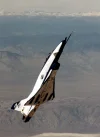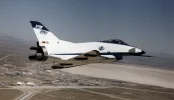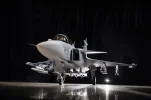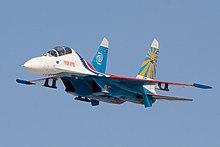Tuossa tosin mainitaan II ja III -lentoalueiden osalta myös "recovery" eli kone sakkaisi (tai ainakin se olisi vaarana?) noilla kohtauskulmilla.
Jossain kuulin maininnan että Gripenin ohjausjärjestelmän kohtauskulmarajaa olisi myöhemmin laskettu 26 asteeseen. Olisiko niin että isommilla kohtauskulmilla koneen sakkaamisen riski kasvaa ja ainakin rauhanajan lentelyyn tuollainen raja olisi pistetty. Tai sitten koneessa on "soft limit/hard limit" tyylinen ratkaisu kuten Su-27:ssa.
Deltasiipiset koneet eivät yleensä ole mitään kohtauskulmahirviöitä. Mirage 2000:n kohtauskulmaraja on 29 astetta ja Typhoonilla tiettävästi niinkin huono kuin 24 astetta. Drakenilla piti kohtauskulmaa koko ajan vahtia ettei kone joudu hengenvaaralliseen sakkaustilaan. Deltasiivellä on monia etuja, mutta matalilla nopeuksilla liikehtiminen ei kuulu niiden vahvuuksiin.
En ota kantaa Gripeniin, mutta korjataan muutamia muita asioita.
Aerodynamiikka on nimittäin vaikeaa
 Ja melkein kaikki muukin hävittäjiin ja ilmailuun liittyvä asia.
Ja melkein kaikki muukin hävittäjiin ja ilmailuun liittyvä asia.1. Lähes kaikki hävittäjät ovat nykään deltasiipisiä
2. Syy siihen on, että deltasiivellä on monia etuja. Yksi niistä on, ettei se tahdo sakata, jos tehoa riittää. Tämä johtuu ns. Vortexeista.
https://en.wikipedia.org/wiki/Delta_wing
As the angle of attack increases, the leading edge of the wing generates a vortex which energizes the flow on the upper surface of the wing, delaying flow separation, and giving the delta a very high stall angle. A normal wing built for high speed use typically has undesirable characteristics at low speeds, but in this regime the delta gradually changes over to a mode of lift based on the vortex it generates, a mode where it has smooth and stable flight characteristics.
Tässä kuva eri tyyppisistä lift / stall käyristä.

http://code7700.com/aero_stall.htm
3. Deltasiipisiä koneita on valtavan paljon erilaisia. Siiven muoto ja ohjauspintakonfiguraatio tekevät niistä varsin eri tavoin käyttäytyviä. On siis harhaanjohtavaa puhua "deltasiipisistä koneista" ja luokitella ne yhteen karsinaan. Katso myös kohta 1.
Erityisesti kannattaa wikipedia-artikkelista lukea tämä.
The canard delta
A lifting-canard delta can offer a smaller shift in the center of lift with increasing Mach number compared to a conventional tail configuration.
An unloaded or free-floating canard can allow a safe recovery from a high angle of attack.
Depending on its design, a canard surface may increase or decrease longitudinal stability of the aircraft.[17][18]
A canard delta foreplane creates its own trailing vortex. If this vortex interferes with the vortex of the main delta wing, this can adversely affect the airflow over the wing and cause unwanted and even dangerous behaviour. In the close-coupled configuration, the canard vortex couples with the main vortex to enhance its benefits and maintain controlled airflow through a wide range of speeds and angles of attack. This allows both improved manoeuvrability and lower stalling speeds, but the presence of the foreplane can increase drag at supersonic speeds and hence reduce the aircraft's maximum speed.
4. Kuten jo mainittua aikaisemmin, kohtauskulmarajoitus hävittäjillä ei johdu niinkään sakkauksesta, vaan siitä, että niiden lentämistä ei enää pystytä hallitsemaan, jos ohjainpinnat menettävät tehonsa, jolloin ne saattavat eri tavoin karata käsistä.
Case-in-point on esimerkiksi Drakenin supersakkaus, joka johtuu siitä, että korkeammilla ohjauskulmilla siiven takareunassa olevat ohjauspinnat sakkaavat ja menettävät tehonsa, kun ne häiriintyvät ilmavirrasta ja pyrkivät säilyttämään koneen asennon hallittuna, jolloin niiden kohtauskulma on suurempi kuin itse koneen siiven.
http://saab.com/region/saab-austral...stralia/2015/cold-war-warrior-and-test-pilot/
The 'double-delta' configuration of the Draken was prone to a phenomenon known as the 'super-stall' where the elevons are blanked at high angles of attack and become ineffective.
http://www.seepia.org/html/seepia5/siipi/siipi.shtml
Draken-suihkuhävittäjällä, esiintyy myös ilmiö nimeltä supersakkaus. Tällöin koneen ohjainpinnat, jotka sijaitsevat siiven takaosassa, sakkaavat, eikä korjaaminen enää onnistu.



 ).
).




